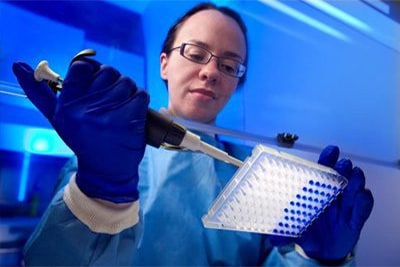AMD: Developing Faster Tests
When people in a community are sick, time can be of the essence. The sooner public health professionals can identify which pathogen is making people sick, the sooner they take steps to protect people and stop further illnesses. AMD methods are giving public health departments the ability to identify infectious pathogens faster than ever before. Additionally, AMD provides important information on characteristics of pathogens, such as whether they are resistant to antimicrobials or vaccines, not seen with earlier testing methods. Below are some of the areas where CDC is using AMD technologies to develop faster, better tests.

Using metagenomics, researchers can sequence everything in a patient’s sample and amplify the pathogens without the need to isolate and grow them first.
Imagine taking a small clinical sample, such as a drop of blood, and being able to detect and sequence any infectious pathogens in just a matter of minutes. That is what metagenomics could do to help us fight diseases. And CDC is leveraging AMD technologies to help develop metagenomics methods to detect all types of infectious diseases, including foodborne bacterial infections, influenza, tuberculosis, and parasitic diseases. With AMD methods, we may one day have a rapid testing scheme for any illness that not only tells us what pathogen caused it, but also important genetic information, such as its specific strain and whether it is resistant to antimicrobials.
Blood may be collected with a finger prick and the test results can be given back to the person within the same day.
Early testing is crucial to curbing the spread of HIV. People are most infectious, and most likely to transmit the virus to others, in the early stages of infection. However, before current rapid HIV tests can detect the virus a person must be infected for 3 to 12 weeks, precious time in which they could be unknowingly infecting other people. CDC scientists are using AMD to develop new rapid diagnostic tests that will detect HIV sooner. Blood may be collected with a finger prick and the test results can be given back to the person within the same day. These methods are less costly than traditional tests and do not require specialized equipment. With these new, accurate, affordable, and portable tests, people can find out within days of transmission whether they have contracted HIV. They will be able to start taking antiretroviral medications and other precautions as soon as they know and reduce their risk of spreading the virus to others. Through this work, CDC scientists are gaining valuable information that will lead to improved HIV testing and more rapid diagnoses.